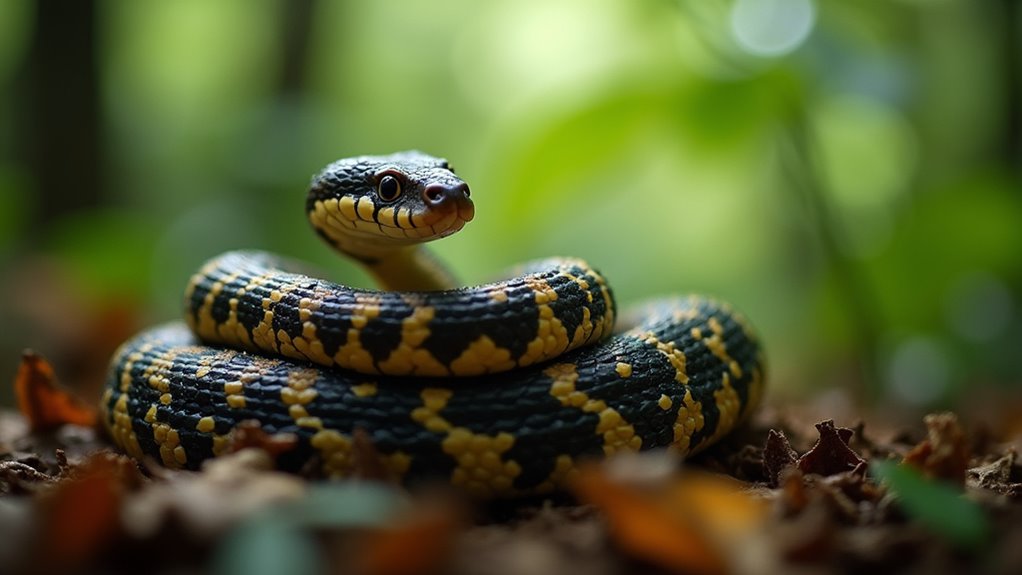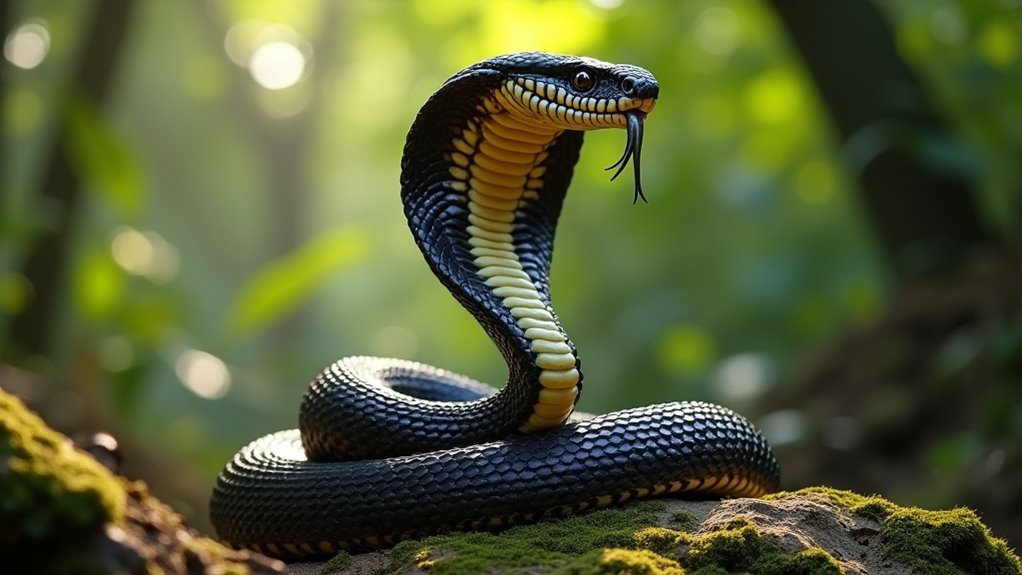Physical Address
304 North Cardinal St.
Dorchester Center, MA 02124
Physical Address
304 North Cardinal St.
Dorchester Center, MA 02124

Never explore Laos unprepared—these seven deadly animals lurk in forests and villages, waiting to turn adventure into peril.
Laos hosts seven deadly creatures you should watch for: the Malayan Krait with its painless but lethal bite, disease-carrying mosquitoes, massive King Cobras, deceptively dangerous Sun Bears with powerful claws, stealthy Clouded Leopards, rabid dogs (especially in rural areas), and the well-camouflaged Green Tree Pit Viper. When exploring Laotian forests or villages, proper precautions can mean the difference between an amazing adventure and a life-threatening encounter. Discover how to protect yourself from these formidable threats.

If you’re exploring Laos’s diverse wildlife, you should know about the Malayan Krait, one of Southeast Asia’s deadliest snakes. This nocturnal predator, scientifically known as Bungarus candidus, possesses venom 15 times more potent than a cobra’s.
You’ll find these snakes near water sources in moist forests and plantations. Despite their lethal capabilities, they display generally non-aggressive behavior unless cornered or threatened. What makes them particularly dangerous is their painless bite, which often delays treatment.
By the time symptoms appear, the powerful neurotoxin may already be causing respiratory failure. Knowing how to say medical emergency phrases in Vietnamese could be lifesaving when traveling in rural areas where this snake is found.
In rural Laos, where traditional remedies are common and medical facilities scarce, krait bites can be fatal without proper antivenom. If you’re hiking at night, wear closed shoes and use a flashlight, as these banded or solid black snakes are most active after dark.
While the Malayan Krait poses a significant threat, it’s actually mosquitoes that represent Laos’s most dangerous wildlife. These tiny insects are the primary vectors for dengue fever, which has affected over 20,000 people in Laos in 2024 alone.
Though the Malayan Krait is fearsome, mosquitoes reign as Laos’s deadliest wildlife, spreading dengue to thousands annually.
You’ll find mosquito populations surge during the June-September monsoon season, especially in Vientiane and southern provinces where dengue is hyperendemic. The World Mosquito Program has implemented Wolbachia mosquitoes as a safe and effective prevention method in Laos since 2022.
The Wolbachia method has reduced cases by 60% in some areas, but you should still take precautions:

When you encounter the king cobra in Laos’s forests, you’re face-to-face with the world’s longest venomous snake. These formidable predators reach 3-4 meters on average, with some exceeding 5.5 meters. Their olive-green scales provide perfect camouflage in dense vegetation.
You’ll recognize them by their distinctive hood, which expands when threatened. Their neurotoxic venom is potent—a single bite delivers 400-600 mg, while just 20 mg can be lethal to humans. The king cobra is among the deadliest creatures found throughout Southeast Asia, including neighboring Malaysia.
Kings primarily hunt other snakes, striking with deadly precision. Their powerful digestive system allows them to go without eating for months after consuming a large meal.
Unlike other snakes, they build leafy nests for their 20-40 eggs, which the female guards until hatching.
Unfortunately, these magnificent creatures face multiple threats, including habitat loss and illegal wildlife trade, earning them a Vulnerable status on the IUCN list.
Despite their name suggesting sunshine and warmth, sun bears rank among Laos’s most deceptively dangerous mammals. These smallest members of the bear family roam Laotian rainforests with deadly curved claws and powerful jaws that can inflict serious injuries when provoked.
Don’t let their cute name fool you—Laos’s sun bears are small but armed with lethal claws and crushing jaws.
You’ll rarely spot these nocturnal creatures during daylight hours, but if you venture into their territory, be aware of their unpredictable nature. While populations have declined by over 30% in the last three decades due to poaching and habitat loss, encounters still pose significant risks. When startled or protecting cubs, they transform from seemingly docile animals into fierce defenders.

Hidden among the dense Laotian forests, clouded leopards reign as some of Southeast Asia’s most elusive and formidable hunters. You’ll rarely spot these medium-sized cats with their distinctive cloud-like coat patterns that provide perfect camouflage in their forest habitat.
Don’t let their smaller size fool you—weighing between 25 and 44 pounds, these nocturnal predators are incredibly agile climbers with exceptionally long tails for balance.
They’ll stalk prey both on the ground and in trees, using stealthy ambush tactics to catch small mammals, birds, and reptiles. Their massive canine teeth, about three times the length of their socket width, make them exceptionally effective predators despite their size.
While clouded leopards typically avoid humans, their declining population due to habitat loss makes conservation essential.
If you’re exploring Laos’s evergreen forests, remember you’re in their territory—these solitary, territorial predators deserve both your respect and distance. Unlike the deadly creatures found in the Philippines, clouded leopards rarely pose a direct threat to humans unless provoked or cornered.
While the majestic clouded leopard often captures the imagination of visitors to Laos, rabid dogs pose a far more immediate danger, particularly in rural communities. With a staggering 68.4% positivity rate among tested canines, rabies remains endemic throughout the country, with transmission peaking during the dry season (November-April). A tragic example underscores this threat: a 12-year-old boy died after being bitten by a dog in his own yard.
When traveling through Laos, be aware of these rabies risk factors:
You’ll need immediate medical attention if bitten, as this preventable disease remains nearly 100% fatal once symptoms appear.

Among the many fascinating creatures you’ll encounter in Laos, the Green Tree Pit Viper might be the most dangerous you’ll never see until it’s too late. These snakes blend perfectly into the lush vegetation of Southeast Asian forests with their bright green scales.
Hidden in plain sight, these emerald assassins await—masters of camouflage in Laos’s verdant jungles.
You’ll find them throughout Laos, often hiding in low branches near water or in agricultural areas. They’re primarily nocturnal, but don’t let your guard down on cloudy days. The white-lipped pit viper is recognizable by the distinctive pale coloration along the sides of its head below the eyes.
Their hemotoxic venom causes severe bleeding, tissue damage, and pain. Hemotoxic venom targets the circulatory system and destroys red blood cells. Rural areas have limited antivenom access, making these encounters potentially deadly.
When exploring Laos’s forests or working in plantations, wear boots and watch where you place your hands.
Children are especially vulnerable due to their size and curious nature.
Laos’s wildlife is as beautiful as it’s deadly. You’ve now discovered the creatures you should steer clear of during your journey through this Southeast Asian paradise. Whether you’re trekking through dense jungles, exploring rural villages, or swimming in local waters, stay alert, stay informed, and stay safe. Remember: respect these animals from a distance, carry appropriate medical supplies, and know emergency procedures—your life may depend on it.